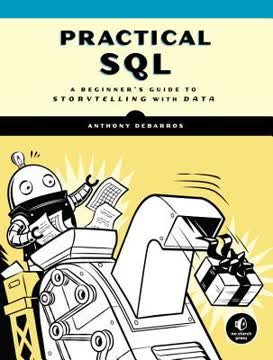Key Takeaways
1. Master Excel for Data Analysis and Visualization
Excel is a very versatile tool that plays a pivotal role in the data analysis process for most companies.
Excel's power and ubiquity. Excel remains the most widely used analytical tool in business due to its versatility and accessibility. It offers a range of powerful features for data manipulation, analysis, and visualization:
- Core functionalities: Sorting, filtering, conditional formatting, charts, pivot tables
- Data analysis capabilities: What-if analysis, statistical functions, data modeling
- Visualization tools: Pie charts, maps, KPIs, hierarchies, drill-down capabilities
Excel limitations. While Excel is essential for data ninjas, it's important to recognize its limitations:
- Collaboration challenges
- Data integrity issues with multiple versions
- Scalability constraints for very large datasets
To maximize Excel's potential, focus on mastering formulas, data importing techniques, and advanced features like PowerPivot and PowerQuery.
2. Conquer SQL to Access and Manipulate Relational Databases
SQL is the primary language used to request information from a database and it is everywhere.
SQL's ubiquity and power. Structured Query Language (SQL) is the standard for interacting with relational databases, which store vast amounts of business data. Key benefits of SQL include:
- Ability to query and update data in databases
- Rapid data retrieval and analysis
- Relating data from different tables using JOINs
- Handling large datasets and concurrent users
SQL fundamentals. To become proficient in SQL, focus on mastering:
- Data Manipulation Language (DML): SELECT, INSERT, UPDATE, DELETE
- Data Definition Language (DDL): CREATE, ALTER, DROP
- Joins, aggregations, and subqueries
- Database design principles and normalization
While there are different flavors of SQL (e.g., MySQL, PostgreSQL, Oracle), the core concepts remain consistent across platforms. Practice writing queries regularly to build your skills.
3. Understand Data Warehousing for Enterprise-Scale Analytics
The Data Warehouse proves to be especially relevant because data and information are extracted from heterogeneous production data sources as they are generated, or in periodic stages, making it simpler and more efficient to run queries over data that originally came from different sources.
Data warehouse essentials. A data warehouse is a centralized repository that consolidates data from various sources across an organization. Key benefits include:
- Standardization of data across departments
- Historical data preservation for trend analysis
- Improved data quality and consistency
- Enhanced query performance for large-scale analytics
Dimensional modeling. Understanding dimensional modeling is crucial for effective data warehouse design:
- Fact tables: contain quantitative measurements
- Dimension tables: provide context and descriptive attributes
- Star schema: a common structure with a central fact table surrounded by dimension tables
Familiarize yourself with ETL (Extract, Transform, Load) processes and data warehouse architecture to better understand how data flows from source systems to analytical tools.
4. Learn Programming to Automate and Enhance Data Analysis
Coding isn't particularly easy to learn but that's exactly why it's so valuable. Even if you have no plans to become a software developer, spend a few weeks or month learning to code and I can guarantee it will sharpen your ability to troubleshot and solve problems.
Programming benefits for data analysis. Learning to code enhances a data ninja's capabilities by enabling:
- Automation of repetitive tasks
- Creation of custom analytical tools
- Handling of complex data transformations
- Implementation of advanced statistical models
Getting started with programming. Begin with a language well-suited for data analysis, such as Python or R. Focus on:
- Basic syntax and data structures
- Data manipulation libraries (e.g., pandas for Python)
- Data visualization tools (e.g., matplotlib, ggplot2)
- Statistical analysis packages
Start with simple scripts and gradually build more complex programs. Consistent practice and application to real-world problems are key to developing programming proficiency.
5. Develop Predictive Analytics Skills for Future-Focused Insights
Predictive analytics is no longer science fiction — it is something that is actually happening, and more than likely will be coming to a company near you.
Predictive analytics importance. This advanced form of analytics uses historical data to forecast future trends and behaviors, enabling organizations to:
- Make data-driven decisions
- Identify potential risks and opportunities
- Optimize business processes
- Gain competitive advantages
Key predictive techniques. Familiarize yourself with common predictive modeling approaches:
- Regression analysis
- Time series forecasting
- Classification algorithms
- Clustering methods
Learn to use tools like R, Python, or specialized predictive analytics software. Focus on understanding the underlying statistical concepts and how to interpret model results for business stakeholders.
6. Adapt to Emerging Technologies and Industry Trends
It is not the strongest of the species that survives, nor the most intelligent that survives. It is the one that is most adaptable to change.
Embracing change. The field of data analytics is rapidly evolving. Stay relevant by:
- Monitoring industry trends and emerging technologies
- Continuously learning and updating your skills
- Experimenting with new tools and techniques
- Attending conferences and networking events
Key trends to watch. Keep an eye on developments in:
- Big Data technologies (e.g., Hadoop, Spark)
- Machine learning and artificial intelligence
- Cloud-based analytics platforms
- Data privacy and security regulations
Cultivate a growth mindset and be prepared to adapt your skillset as new technologies emerge and business needs evolve.
7. Cultivate a Data Ninja Mindset for Career Success
As a data ninja of your organization, you might not be explicitly responsible for playing the role of a DBA, but it still might be worthwhile for you to have some rudimentary understanding of the concepts of the DBA in general. This will make you more versatile, and hence more marketable in the industry.
Holistic understanding. Successful data ninjas develop a broad understanding of the data ecosystem:
- Data sources and collection methods
- Storage and processing technologies
- Analysis and visualization techniques
- Business applications and decision-making processes
Key attributes of data ninjas:
- Curiosity and problem-solving mindset
- Strong communication skills
- Attention to detail and data quality
- Ethical considerations in data handling
Continuously expand your knowledge beyond your primary role. Understand how your work fits into the larger data analytics workflow and impacts business outcomes. Develop soft skills like project management and stakeholder communication to enhance your value to organizations.
Last updated:
FAQ
1. What’s "A Game Plan for Success in Data Analytics" by Fru Nde about?
- Beginner’s Guide to Data Analytics: The book provides a high-level overview of the essential tools, concepts, and skills needed to start a career in data analytics, especially for beginners.
- 5-Point Game Plan: It introduces a structured five-step approach: Master Excel, Conquer SQL, Tame Data Warehousing, Pick Up Coding, and Continue Adapting.
- Focus on Practical Skills: Rather than deep technical tutorials, the book offers practical advice, industry context, and curated resources for self-study.
- Career Orientation: It targets aspiring data professionals (Data Ninjas), helping them understand roles, required skills, and industry expectations.
2. Why should I read "A Game Plan for Success in Data Analytics" by Fru Nde?
- Entry-Level Friendly: The book is designed for newcomers with little or no experience in data analytics, making it accessible and unintimidating.
- Career Advancement: It provides actionable steps and resources to help readers land their first job, make a career change, or progress in their current roles.
- Comprehensive Overview: Readers gain a broad understanding of the data analytics landscape, including tools, roles, and industry trends.
- Resource-Rich: Each chapter ends with curated resources for further learning, making it a practical guide for self-driven learners.
3. Who is the ideal reader for "A Game Plan for Success in Data Analytics" by Fru Nde?
- Aspiring Data Professionals: The book is aimed at those interested in starting a career in data analytics, regardless of technical background.
- Career Changers: Individuals looking to transition into data roles from other fields will find the guidance and resources especially helpful.
- Curious Learners: Anyone seeking to understand the basics of data analytics, tools, and industry expectations will benefit.
- Entry-Level Candidates: The content is tailored for those at the beginning of their data journey, not for advanced practitioners.
4. What is the "5-Point Game Plan" outlined in "A Game Plan for Success in Data Analytics" by Fru Nde?
- Master Excel: Learn to use Excel for data manipulation, analysis, and presentation, as it remains a foundational tool in analytics.
- Conquer SQL: Gain proficiency in SQL to query, manage, and analyze data stored in relational databases.
- Tame Data Warehousing: Understand the basics of data warehousing, including architecture, dimensional modeling, and its role in consolidating data.
- Pick Up Coding: Develop basic programming skills to automate tasks, analyze data, and solve business problems.
- Continue Adapting: Embrace continuous learning and adaptability to keep up with evolving technologies and industry trends.
5. How does "A Game Plan for Success in Data Analytics" by Fru Nde define a "Data Ninja" and what roles do they play?
- Definition of Data Ninja: A Data Ninja is an entry-level, unspecialized individual who works with data to collect, organize, and interpret it for actionable insights.
- Versatile Skill Set: Data Ninjas are expected to be multi-skilled, using various tools and techniques to transform raw data into information.
- Industry Roles: They can work in diverse industries (healthcare, finance, retail, government, etc.) and perform roles such as data analyst, report writer, or business intelligence professional.
- Interpreter of Data: Data Ninjas act as interpreters, ensuring that data is accurately analyzed and communicated to support business decisions.
6. What are the key skills and tools recommended in "A Game Plan for Success in Data Analytics" by Fru Nde?
- Technical Skills: Proficiency in Excel, SQL, understanding of data warehousing concepts, and basic programming are emphasized.
- Soft Skills: Communication, critical thinking, business acumen, and attention to detail are highlighted as essential for success.
- Recommended Tools: The book suggests starting with Excel, SQL Server, and learning about data warehousing and programming languages.
- Continuous Learning: Emphasis is placed on ongoing training and practice, with resources provided for self-study.
7. How does "A Game Plan for Success in Data Analytics" by Fru Nde explain the importance of Excel for data professionals?
- Ubiquity and Versatility: Excel is widely used for data manipulation, analysis, and presentation, making it a must-know tool for data professionals.
- Core Functionalities: Features like sorting, filtering, pivot tables, charts, and the Analysis ToolPak are essential for analyzing and visualizing data.
- Limitations Acknowledged: The book discusses Excel’s drawbacks (e.g., collaboration, scalability, data integrity) and when to consider other tools.
- Integration with Power BI: It introduces Power BI as an extension of Excel’s capabilities for more advanced analytics and visualization.
8. What is SQL and why is it essential according to "A Game Plan for Success in Data Analytics" by Fru Nde?
- Definition and Ubiquity: SQL (Structured Query Language) is the standard language for querying and managing data in relational databases, used across industries and applications.
- Key Benefits: SQL enables efficient data retrieval, updates, and reporting, supports large datasets, and allows for concurrent multi-user access.
- Core Concepts: The book covers DML (Data Manipulation Language), DDL (Data Definition Language), DCL (Data Control Language), and TCL (Transaction Control Language).
- Relevance: Mastery of SQL is crucial for data professionals, as most organizational data resides in relational databases.
9. What is data warehousing and why should data professionals understand it, according to "A Game Plan for Success in Data Analytics" by Fru Nde?
- Centralized Data Repository: A data warehouse consolidates data from multiple sources, providing a single version of the truth for analysis and reporting.
- Architecture and ETL: Understanding the flow of data from source systems through ETL (Extract, Transform, Load) processes into the warehouse is key.
- Dimensional Modeling: The book introduces fact and dimension tables, explaining how dimensional modeling supports efficient querying and analysis.
- Business Impact: Data warehousing standardizes data, improves data quality, and enables historical analysis, making it vital for decision support.
10. Why does "A Game Plan for Success in Data Analytics" by Fru Nde emphasize learning programming for data analysis?
- Problem-Solving Tool: Programming enables automation, data manipulation, and the creation of custom solutions for complex business problems.
- Gateway to Advanced Analytics: As data tasks become more complex (e.g., big data, data science), programming skills become increasingly important.
- Recommended Approach: Start with beginner-friendly languages (e.g., VB.NET, Python), focus on concepts, and practice regularly to build competence.
- Broader Learning: Programming fosters computational thinking, creativity, and adaptability—skills valuable beyond just coding.
11. How does "A Game Plan for Success in Data Analytics" by Fru Nde address the need for continuous adaptation in the data field?
- Rapid Technological Change: The book highlights the fast pace of change in data tools, technologies, and methodologies.
- Predictive Analytics and Emerging Trends: It discusses the rise of predictive analytics, big data, and the importance of staying current with industry developments.
- Evolutionary vs. Revolutionary Change: Readers are encouraged to adapt to both incremental (evolutionary) and disruptive (revolutionary) changes in the field.
- Lifelong Learning: Emphasis is placed on curiosity, flexibility, and ongoing education to remain relevant and successful as a data professional.
12. What are the key takeaways, best quotes, and resources from "A Game Plan for Success in Data Analytics" by Fru Nde?
- Key Takeaways: Master foundational tools (Excel, SQL), understand data warehousing, learn programming, and commit to continuous learning and adaptation.
- Best Quotes: Notable quotes include “Numbers have an important story to tell. They rely on you to give them a clear and convincing voice.” (Stephen Few) and “It is not the strongest of the species that survives, nor the most intelligent that survives. It is the one that is most adaptable to change.” (Charles Darwin).
- Resource Lists: Each chapter ends with curated resources—websites, tutorials, books—for further study in Excel, SQL, data warehousing, and programming.
- Practical Advice: The book stresses the importance of communication, business understanding, and the ability to translate data into actionable insights.
Review Summary
Head First SQL receives mostly positive reviews, praised for its beginner-friendly approach and entertaining style. Readers appreciate its clear explanations and practical examples. Some criticize outdated syntax and technical errors. The book is highly recommended for SQL novices but may not suit those seeking advanced content. Many readers find it enjoyable and effective for learning basic SQL concepts. Some suggest it's best for MySQL users and advise checking documentation for other database systems. Overall, it's considered a good starting point for SQL beginners.
Similar Books








Download PDF
Download EPUB
.epub digital book format is ideal for reading ebooks on phones, tablets, and e-readers.




